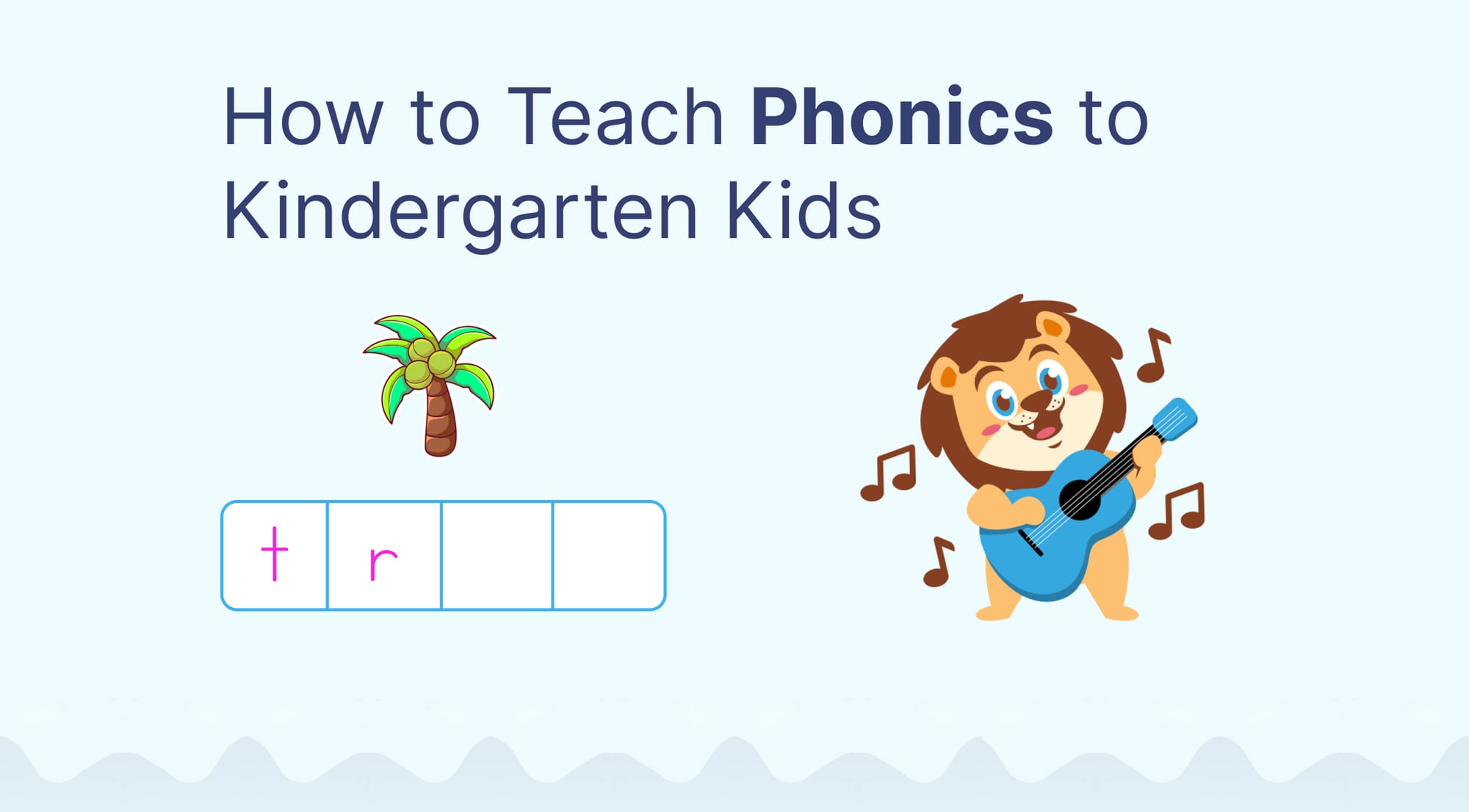How to Teach Phonics to Kindergarten Kids (2024)
Discover 10 strategies for teaching phonics to kindergarten kids. Implement playful techniques designed to make learning phonics fun and exciting!
Hey there, fellow kindergarten teachers! As we all know, teaching phonics is an essential part of our curriculum. It lays the foundation for our students' literacy development and sets them up for success in their future reading and writing endeavors.
Get ready to dive into the most popular methods teachers LOVE for teaching phonics in kindergarten!
- Letter-Sound Relationships
- Phonics Songs
- Blending and Segmenting
- Phonetic Decoding
- Phonics Games
- Phonics Worksheets
- Sight Words
- Assessing Students
- Phonics apps
- Get Parents Involved
Put these strategies into action and witness the remarkable progress in your kindergarteners' reading skills development.

Phonics Basics
Before diving into the fun stuff, let's quickly review the basics of phonics. Phonics is the relationship between sounds (phonemes) and the letters that represent them (graphemes). It's based on the alphabetic principle, which is the idea that letters represent sounds in an organized way.
Before our kiddos can understand the relationship between letters and sounds in written language (phonics), they need to develop an understanding, or awareness, of the individual sounds (phonemes). Phonemic awareness skills include tasks like identifying and manipulating individual sounds in words, which are auditory skills. These skills are important for our kids to learn before they can effectively learn phonics.
Two quick pro tips to remember:
- Once they developed phonemic awareness, and understand that words are made up of individual sounds, our young readers are better equipped to begin learning phonics.
- When teaching phonics, it's important to be methodical and clear - starting with simple concepts and gradually progressing to more complex ones. Teaching phonics should include a variety of methods, from individual study to group lessons, interactive activities, and parental input.
So let's get right to it!
Letter-Sound Relationships
Once your students have a good grasp of phonemic awareness, start teaching them letter-sound correspondences. You can show them letter names and shapes and then dive into the sounds each letter makes.
Multi-sensory activities that combine listening, reading, speaking, and touching are excellent for your phonics toolbox. These letter sound activities for kindergarten are a good place to start:
- Say-Touch-Spell - Using tiles with letters and letter sounds (like: ch, sh, ck), say a word to your students and have them say it back, touching each letter or letter sound as they do. This helps them associate the sound with the letter, and learn to spell at the same time. 😊
- Tactile - Set up small sandboxes or shaving cream boards. Have the kiddos use these to draw letters as you sound them out.
- Mnemonics - Use visual aids with specific words, and add hand gestures that match it. For instance, you might say, "S is for snake, /s/, /s/, /s/" while making a slithering motion with your hands
Involving multiple senses keeps learning fun and helps to reinforce the letter-sound relationship. You can find lots of cool multi-sensory ideas here.
Phonics Songs
One of the most effective methods for memorizing something is through songs! Reflect on your own school days; I bet there are songs from that time that you still remember, even though it's been a while since you last thought of them. When our little ones listen to songs designed to teach phonics, they'll learn without even realizing it.
You can find songs on YouTube that are specific to phonics. Some of these videos even have on-screen lyrics, which can be shown to the kids as they sing along. If the words are not available on-screen, print them on a poster board or paper and hold them each time they come up in the song.
Repetition is the key to memorization, and singing along is a great way to encourage our kids and get them excited. You can incorporate phonics songs into other parts of the day as background music. This will help reinforce phonics learning even while teaching other subjects.
Blending and Segmenting
Blending and segmenting are two essential skills for decoding words. Blending involves combining individual sounds to form words, while segmenting is breaking words into individual sounds. You can teach these skills through a variety of oral activities, such as:
- Playing "I Spy" with CVC (consonant-vowel-consonant) words
- Blending and segmenting words using Elkonin (sound) boxes
- Using manipulatives (e.g., blocks, beads) to represent sounds in words
As your students progress, move on to more complex phonics patterns, like consonant blends, and long vowel sounds. These, along with other phonemic awareness exercises for kindergarten break words and sounds into easy-to-understand parts.
Phonetic Decoding
Teaching decoding strategies is about giving your students the tools to tackle unfamiliar words. During phonic decoding, also known as “word identification,” students identify the individual letters of a word and relate the correct phoneme to each letter. Blending those phonemes, or sounds, allows the student to identify the word. A few popular decoding activities for kindergarteners include:
- Chunking - Breaking words into smaller, manageable parts
- Syllabication - Dividing words into syllables
- Sounding out words
Provide plenty of opportunities for your students to practice these phonics and decoding strategies through guided reading, word sorts, and decodable texts.
Phonics Games
Kindergarten phonics games are a fantastic way to make phonics instruction engaging and fun for our young learners. A few teacher-favorite phonics games include:
- Phonics board games - like Bingo and Word Pop
- Online games - like "Starfall" and "ABC Ya!" These interactive, online games are great for individual or home study
- DIY games - like letter hopscotch and scavengers hunts
Phonics games for early literacy are extremely effective for improving reading skills. Try creating a game-rich learning environment by setting up phonics centers, incorporating game time during small group instruction, and encouraging students to play phonics games during free-choice time.
Phonics Worksheets
While games and hands-on activities are great, phonics worksheets and printables also play an important role in teaching. These provide extra practice and reinforcement. You can also choose phonics worksheets for kindergarteners based on each student’s progress.
A good practice is to use a mix of phonics worksheets:
When selecting phonics resources, look for those that align with your teaching method. Use these resources during independent study, group time and for reinforcement at home.
Sight Words
Sight words include irregularly spelled words that cannot be easily decoded using phonics rules alone. Teaching sight words alongside phonics can significantly improve our students' reading fluency and comprehension.
How you ask? By recognizing sight words quickly, students can focus on decoding unfamiliar words using some of the phonics strategies we mentioned. The more words our young readers can instantly recognize, the more time they have to focus on other, less familiar, words. This leads to more small wins, and less frustration!
You can use these sight word lists in your lessons:
Assessing Students
Regular assessment is key to effective phonics lessons. By doing so, we assess not only our students, but also ourselves. It's important that we, as teachers, know which method is most efficient for each of our students.
Use a mix of formative and summative assessments, such as:
- Informal observations during small group instruction
- Running records and decoding assessments
- Phonics skills inventories
- End-of-unit testing
When you identify struggling learners, try to provide targeted interventions and extra support, such as additional small-group instruction, one-on-one tutoring, and materials suited to their current level.
Phonics apps
Technology is a valuable tool in teaching practically all subjects, including phonics. Many free apps have sounding tools, rhyming games, and matching games to teach and reinforce phonics.
Hooked on Phonics and ABCmouse are two popular, trusted sites for phonic games and learning tools.
Get Parents Involved
We can’t stress enough how important it is to involve parents in the learning process. Send home worksheets and fun game ideas for parents to play with their little ones.
If you find that some students lack the home support they might need, try curving out some added individual time at school. You might be shaping the mind of the next Einstein. 💕
Conclusion
Teaching phonics to kindergarteners is an incredible mission, and very rewarding. By mixing fun activities with systematic instruction and targeted support, you can help your students develop a strong phonics foundation.
So go ahead! Try a few of these ideas and strategies in your classroom. If you have a favorite phonics activity or resource, make sure to include it in your own toolbox. The foundation you create will be the base of your students' reading and writing future. Remember to be creative, responsive to your kids' needs, and, most importantly, have fun!

